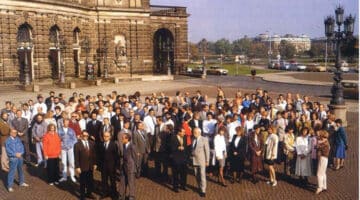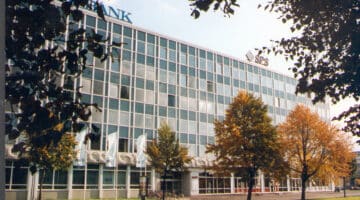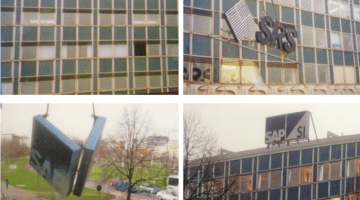After the fall of the Berlin Wall in 1989, Dresden became a key business location for SAP in the former East Germany. Besides modernizing businesses there, SAP offered something precious in those uncertain times: secure jobs.
After the Wall came down in November 1989, many West German companies, including SAP, rushed to open offices in Berlin. In 1990, the SAP Executive Board in Walldorf decided that the fastest way to gain a foothold in East Germany would be a joint venture with ROBOTRON-Projekt Dresden (RPD), a leading software enterprise in the German Democratic Republic and, with the data and IT division of Siemens, already a strategic SAP partner. It was not about turning a quick profit, though: Dresden would go on to become an important base for SAP’s business, and remains so today, 30 years after German reunification.
Before 1989
Dresden was home to a software industry before 1989. “RPD was founded in 1984 because East Germany had realized that software was vital to running enterprises successfully. This also paved the way for joint East-West IT projects,” says Hans-Jürgen Lodahl, who was managing director of RPD at the time, and who later became one of the three founding managers of the joint venture.
In 1985, RPD had begun building software for West German companies such as Siemens. “Under what was called import-export coordination, we would procure products from a partner company in the West, and it would order software from us,” says Lodahl. “That way, instead of paying for those products in precious hard currency, we provided software in return.”
SAP appointed Wolfgang Kemna as managing director of the joint venture in 1990. Before the Wall came down, he was at Siemens in Munich and would receive delegations from East Germany: “It was the Cold War. We had to work out which computers we could sell them without breaking the U.S. embargo,” he recalls.
Though no-one at SAP could possibly have anticipated how far the political changes in East Germany in 1989 would reach, the company had seen how this type of partnership worked before the Berlin Wall fell. “In September 1989, SAP’s Gerhard Oswald attended a meeting at Siemens in Munich, while Hasso Plattner was in Dresden to see the IT experts at RPD,” says Lodahl.
Then began a chain of events that would culminate in a reunited Germany.
Plans Firm Up
Back then, RPD was an East German software company that employed 1,200 people. It was part of Robotron, a state-owned electronics manufacturer with 68,000 employees. “When the Wall came down, we knew that Robotron had little chance of surviving as a whole. So we set about trying to save as many jobs as we could,” says Lodahl.
Joachim Singer, who after the Wall fell changed career to become HR director of RPD, recalls another problem: “In East Germany, we had tried to imitate as closely as we could the operating systems, database management systems, and mathematical programs of the West. We had essentially reproduced its software programs. So when the Wall came down, at RPD we were worried we’d face claims for royalties. It was clear that it could not continue to exist as it was.”
In mid-March 1990, SAP exhibited at Leipzig’s spring trade fair. Due to the massive surge in the number of exhibitors from the West, there was no room left in the main arena so SAP found itself in the over-spill hall.
With the fair only halfway through, SAP, RPD, and the Data and Information Technology division of Siemens AG announced their plan to set up SRS (Software- und Systemhaus Dresden). A few days later, at the CeBIT ‘90 computer fair in Hannover, West Germany, the SAP Executive Board and RPD’s management continued their talks and firmed up their plans.
In those early days, there was no joint economic strategy for the two Germanys. SAP had however, made certain assumptions about how East Germany’s economic system would change. It set them out in an internal position paper on doing business there, which forecast a real opportunity for SAP R/2, the company’s standard software: “Splitting up the huge state enterprises into smaller, clearly defined businesses will result in an array of firms faced with the task of completely reorganizing and restructuring their operations.”
SAP wanted to gain reference customers rapidly to be able to demonstrate the benefits of its software in the real world, and especially how it could help companies meet new legislation. The first pilot customer was a major steel plant on the border with Poland. It would run SAP R/2 on Siemens C40 computers, with BS2000 as the operating system. At that time, the plant was one of many state enterprises being privatized following the collapse of communism, and in 1990 it became EKO Stahl. Today, it is owned by ArcelorMittal and is still an SAP customer.
New Opportunities
In the meantime, news of the firms’ plans had reached staff at RPD. “My client came into the office brandishing an SAP R/2 brochure and said: ‘You can stop what you are doing. We’ll be working on this software from now on,’” says Rainer Dittrich, who went on to lead the HR consulting unit at SRS and later at SAP.
SRS took on about 300 former RPD employees. Of them, 85 were put on SAP projects. The person charged with getting the new joint venture off the ground on SAP’s behalf was Herbert Kramer. “He was very highly respected by everyone here for the work he did in getting the company up and running,” says Lodahl. “Unfortunately, ill-health meant he later had to hand over that part of his role to Heiner Göhlmann, his deputy.”
Joachim Singer, who became HR director of SRS, recalls that restructuring the business was not all plain sailing: “The managers from SAP and Siemens-Nixdorf charged with setting up SRS had selected a number of Robotron employees to create a layer of management at departmental level. In some cases, the new structure reversed old roles, with former managers becoming employees, and vice versa. That caused some tension.”
After some initial difficulties, things soon settled down at SRS and the framework was in place for a new organizational structure. Petra Schletzke, who today works in SAP Marketing, remembers her interview with one of the managers creating the new entity: “I was working in quality management and had two small children. The interviewers were amazed that I worked while looking after a young family. They gave me a job in the training department.”
Next Stop: SAP Headquarters
Just before Easter in April 1990, Joachim Singer received a telex telling him that at 6:00 a.m. the following Wednesday a bus would be waiting in the Robotron car park in Dresden to take employees to Walldorf for training. Since Easter Monday had just been restored as a public holiday in East Germany, Singer had less than two working days’ notice.
“It wasn’t as simple as just telling staff; I knew I would have to persuade them to go. Hardly anyone here had heard of SAP. But we did have business dealings with Siemens, so many employees wanted to work for them. Besides, the operating system RPD’s workforce was used to, was more like that of Siemens,” says Singer.
Everyone had to decide more or less over Easter whether they wanted to spend the next three months on training courses in Walldorf. Many people at RPD had not yet been to West Germany on business. SRS offered an opportunity. Given that so much was up in the air at that time, it took a great deal of courage to commit to SRS. “When we got on the bus, all we knew was that we were heading to Walldorf. We arrived in a completely new world,” says Dittrich.
It was not just being in a new place that made people feel uneasy. “It was a very political time, and we couldn’t help but wonder whether someone in our group might have been a member of the East German communist party or the secret police. That’s why not all of us immediately felt at ease in the new order,” says Manfred Eilitz, who went on to build SAP’s hosting business in Dresden.
Looking back, Eva Rebitzer recalls how difficult it was for working mothers to drop everything to travel to Walldorf. She was in her mid-twenties and still in the early stages of her career after her apprenticeship at Robotron. “I was one of the few women who were able to come on the first bus. Others joined us later on the next two buses. We’d been told to dress smartly, so most of the men wore dark suits. When we arrived in Walldorf, people at SAP must have thought we’d come for a funeral.”
Rainer Dittrich also remembers this well: “Oh, you were one of the people from the bus,” he has heard on many occasions since. He adds: “For a long time after we used to laugh about it with our developer colleagues in Walldorf, most of whom wore jeans and t-shirts. We ditched the suits pretty quickly.”
The new arrivals from the East were allocated particular subject matters. After a general course on business administration, they were sent off in small groups to learn from the developers working on their respective subjects. Rebitzer, who is still an HR consultant at SAP, recounts how, in the early days when everyone knew everyone in Walldorf, she first encountered co-founder Klaus Tschira: “’Who are you?’ he asked, ‘I haven’t seen you before.’ When I told him that I was part of the delegation from Dresden, he was surprised to learn that we were not all men in dark suits.”
From April 1990, every week for three months the RPD team would travel to Walldorf for training. “Everyone really welcomed the new arrivals from the East. They had the technical expertise. Now they needed to get up to speed on the latest advances in western IT,” says Wolfgang Kemna.
Trust in the Future
At that stage, the team from Dresden had only an assurance that they would be taken on. Right from the start, they had great faith in SAP. “Because we worked so closely with the colleagues in Walldorf, we built trust very quickly,” says Rainer Dittrich. “There were about 100 employees working on HR, who were joined by 10 new people from the East. Working together gave us a sense of security. We also met up after work, had round-table talks, and went sight-seeing. We learned fast what it really means to be an SAP consultant, and we weren’t left on our own.”
When they first arrived in Walldorf, the team from Dresden were welcomed by SAP Co-Founder Hans-Werner Hector, then in charge of training. In July 1990, their three months in Walldorf were over. To mark the end of their time there, co-founder and CEO Dietmar Hopp addressed them at a large farewell event. It was time to return home, he said, and wait for SRS to be founded.
“Dietmar Hopp turned to us and asked that anyone with the slightest doubt about the plans to found the new company raise their hand, and added that if anyone did, SAP would set up its own subsidiary in Dresden. That was a clear signal and no one raised their hand,” Dittrich says.
East Meets West
In the fall of 1990, Wolfgang Kemna headed east. “They were crazy times. One day, I drove to Dresden and had one of the first cell phones with me, though most of the time there was no reception. It was a big adventure for someone like me who had grown up in the West German state of Hesse. Rather than stay in a hotel, I had deliberately chosen to lodge with a family, whose son had taken up an apprenticeship in the west. Staying with them meant I could ask my hosts everything I’d ever wanted to know about life in East Germany.”
SRS’s offices in Dresden were in the former Robotron facilities. They occupied three floors of the main building and a section of the data center, all of which would soon be renovated and re-equipped.
Around the same time, in October 1990, Siemens acquired Nixdorf, the struggling computer company. “SRS’s foundation was delayed, since we had to wait for the new Siemens-Nixdorf to come into being first,” says Joachim Singer. “And the Treuhand, the government agency overseeing East German privatization, still needed to give its go-ahead to Robotron-Projekt GmbH’s stake.”
Finally, on October 15, 1990, less than two weeks after German reunification, SRS was officially founded in Munich, and opened for business on November 1, 1990.
SAP’s Journey to Dresden
Hans-Jürgen Lodahl emphasizes the positive influence that Dieter Matheis, who served as CFO at SAP until 2001, had on the commercial organization of SRS. The person tasked with establishing the joint venture on the Siemens-Nixdorf side was Peter Hutzelmann. He took responsibility for commercial management at SRS, would later become its managing direction, and had a decisive influence on the company’s evolution in the following six years.
“When the company was founded, 325 employment contracts had to be signed all at once. By the end, I wasn’t even sure I could write my name correctly,” remembers Hutzelmann. “And there were traffic jams in all directions on the freeways linking the two Germanys, because October 31 was Reformation Day – a public holiday in the east – and November 1 was All Saints’ Day in the west. The westerners were taking their first day trips to the east, while the easterners returned with their recently purchased used cars and their temporary plates.”
SAP AG and SNI AG each held 45% in the joint company, which was launched with share capital of six million marks, while RPD GmbH held the remaining 10%. “We had originally planned to divide ownership equally, in thirds,” says Hutzelmann, who still has vivid memories of the meeting with Dietmar Hopp, “but RPD could only contribute 10% of the share capital, so our stake increased significantly as a result. I had to arrange that with the SNI board. But before I could even get a meeting there, Hopp had already clarified the share capital issue with SAP’s Supervisory Board.”
Pursuing the Goals Together
“By the end of 1990, half of the SRS share capital was exhausted, but then things improved steadily from there,” remembers Hutzelmann. “A major factor was the more than 50 C40 computers that Siemens-Nixdorf provided free of charge for pilot installations.”
SAP did what it said it would do as part of its East Germany strategy: It primarily hired employees from the former German Democratic Republic. But as Joachim Singer tells it, it wasn’t easy at first for the SRS colleagues who were assigned as consultants on SAP projects: “The companies didn’t like having Robotron employees advising them. The IT equipment in East Germany was never sufficient. It was allocated, not ordered, which is why the Robotron technicians who were known at the companies weren’t very highly regarded.”
This made it very important for the RPD consultants to have experienced SAP lead consultants at their side. One of these lead consultants from Walldorf in the early days was Joachim Prawitz, responsible for the Human Resources area. Wolfgang Kemna remembers him with great respect: “The lead consultants from Walldorf helped to increase acceptance of the East German consultants. For SRS, it was much more important to have good, experienced SAP consultants than good salespeople or developers. There wasn’t much to sell, after all; the projects were ordered and paid for in the west, while the technical expertise was in Dresden. It became clear how important it was for the East German consultants to have assignments on projects in West Germany to learn how projects are executed at SAP and to build their own networks within the company.”
As Kemna tells it, Hans-Jürgen Lodahl was also an important success factor during this time. “He was one of the leading people in the east – and not only in Dresden – with regard to IT, hardware, and software, and had a huge network that helped us repeatedly. Sometimes we didn’t even know what strings he had pulled.”
The Dresden consultants had already gained their first insights into SAP R/3 on training courses in Walldorf, but SAP R/2 was initially planned for the mainframes in the GDR. “We established later that the mainframes in the east weren’t powerful enough to run SAP R/2. It also became clear that the decisions concerning software implementation weren’t being made at the state-owned enterprises and combines in the east, but instead by the parent companies in the west that had acquired them,” says Kemna.
Machine manufacturer VEM Sachsenwerk GmbH Dresden was one of the first companies to start using the SAP R/2 system in 1991, with the RP (Personnel) module, and was the first stock corporation established by the Treuhand in the GDR. The company was allocated to Horst Plaschna Management GmbH & Co Beteiligungs- und Verkaufs-KG Berlin in July 1992, however, and privatized and sold to the Merckle Group of Companies in Blaubeuren in 1997.
With the list of major East German companies that began using SAP R/2 RP for payroll accounting in 1991, to comply with the new laws of the Federal Republic of Germany, the market potential for SAP software in the former East Germany was exhausted for the time being.
Kemna explains how SRS managed to produce a profit from its first year in operation: “The majority of the initial consulting revenue in fact came from projects with customers in the west, since much of the industry in the east had been phased out. Nineteen ninety was too early for East German startups and even so, they would have been too small for our SAP R/2 product.”
Nonetheless, SAP customer numbers in the east grew steadily from 1991, primarily from government-funded orders. The municipal transport services in Dresden and Leipzig chose to implement SAP software, for example, and have remained customers to this day.
SRS benefitted from the advantages of a joint venture: the contacts of all three investor companies and the possibility of offering the equipment, business software, and support from a single source.
Safe Haven
Employees like Rainer Dittrich recognized the opportunity, because rapid deindustrialization resulted in the loss of millions of jobs in the former East Germany. The government responded with job-creation schemes, cuts in working hours, and early retirement options, among other schemes: “The only contact we had with reduced working hours, which so many former GDR citizens were forced to endure after reunification, was a new development for our RP system – because reduced working hours were unheard of in the west in the 1990s.”
But SRS colleagues still faced a wide variety of career challenges. The working methods at the SAP office were ahead of their time even then compared with West German standards at the time. The new colleagues in the East had to make this leap too, besides gaining expertise in SAP products and processes and in general market economy topics.
Petra Röber, now a senior business support specialist at SAP in Dresden, was Peter Hutzelmann’s assistant at the time. A young parent then, Röber was hired by RPD in 1990 and, after Hutzelmann left the company, she continued to work as an executive assistant at SRS before taking on new challenges at SAP. “In the 30 years that I’ve worked for SRS and then SAP, there wasn’t a single year that I didn’t learn an awful lot of new things or develop as a person,” Röber says.
At the same time, SAP employees were used to dealing with one another as equals and with goals in mind. Arrogance has never been part of the SAP culture, so after they got to know each other, both sides quickly transitioned into a productive working relationship. Joachim Singer remembers: “I was surprised that I could turn to my manager when I had problems with our IT initially, and he was very helpful and straightforward.” That’s why he sees his work together with his SAP colleagues as the “best experience of the west” he had in post-reunification times. “When we visited Walldorf, we’d joke about how SAP was the ideal that communism had always pretended to be: free lunch for the employees, company cars for everyone, playing tennis at work…”
They didn’t have much to do with the colleagues in Berlin, but there was still a kind of “noble rivalry” between the locations, recalls Kemna. It was important for SAP that its Berlin operations were not tied to one particular hardware manufacturer so that, alongside the Dresden joint venture with Siemens, it could make sure it did not neglect business relations with other hardware manufacturers like Compaq, HP, and IBM.
Ultimately, the strategy of establishing two business hubs proved to be a sturdy foundation for business in the east. What’s more, SAP offered former GDR experts in Berlin and Dresden a new place to live and work. This also meant that everything they had achieved in their careers before the Wall fell still counted, which was often not the case for people in eastern Germany.
What Happened Next?
SRS was privatized in 1993 and the Treuhand’s 10% share was distributed equally to SAP and Siemens. Siemens-Nixdorf and SAP justified this step during the approval procedures, arguing before Germany’s Federal Cartel Office that, “To date, RPD has not contributed any added value at SRS.” Joachim Singer explains, “Aside from the Robotron employees, who had been part of SRS for three years in the meantime, there were absolutely no connections with Robotron-Projekt. No products had been taken over; aside from the employees and their knowledge – which they had largely acquired from SAP and Siemens, after all – Robotron-Projekt didn’t make any contribution at all.”
Ten years later, SRS had become one of the most important employers in the region. The SAP share of SRS consulting business grew steadily. “SAP experienced an amazing rise, while Siemens-Nixdorf faced its liquidation in 1998,” says Hutzelmann, who joined Siemens in 1996. “As a consequence, SAP took over 100% of SRS.”
In 1997, SRS, SAP System Integration (SAP SI) in Alsbach-Hähnlein, and SAP Solutions in Freiberg am Neckar were all merged to form the new SAP SI. In this form, it was fully absorbed in the parent company in 2008 and moved into the new SAP office building on Dresden’s Postplatz.
Today, Dresden is an important location in the SAP universe – Hans-Matthias Fischer (see box) sees its broad portfolio as one of the key reasons: “The mix of consulting, sales, application management, customer support, IT support, global cloud services, and SAP research makes Dresden strong and attractive. The entire region benefits from SAP Dresden.”
The location will celebrate its 30th birthday in November – and has become an important part of SAP’s story. According to Fischer: “The development of SRS presented a huge opportunity to us, which we faced with courage and ability, and we are still very grateful today to have had that opportunity.”
Employee Spotlights
Bernhard Heininger:
The Workforce Grows
Among the RPD employees were 25 people who were working on SAP software development projects when SRS was founded. Bernhard Heininger had joined SAP in 1986. Though new to management, his expertise in mainframe computers and IBM assemblers meant he was put in charge of the development and project unit at SRS in the fall of 1990. RPD had used assemblers, and SRS wanted to draw on that knowledge. “By that time, Walldorf was working flat-out on SAP R/3. The idea was to use the potential in Dresden also to reduce the development effort on SAP R/2 in Walldorf.”
In the years that followed, Heininger expanded his team of developers in Dresden so that besides ABAP and assembler projects it could also get up to speed on new technology projects such as the early watch service and IT support. “I commuted between Walldorf and Dresden for four years. At first, I stayed in a hotel and flew home every week. But arriving at Dresden airport used to take forever, and made the journey extremely long. Later, I’d drive between my home and a second home near work every two weeks.”
The aim was for the team of developers in Dresden to become more autonomous with each project they took on. “My staff were mostly older colleagues who found my anti-authoritarian management style rather strange to begin with, since it was so different to what they had known before,” says Heininger. “After all, I was doing everything I could to make sure they could do their jobs without me as an external development manager.”
Heininger succeeded: By 1994, his work in Dresden was complete and he moved to California for the next chapter in his career. He retired in 2016 after 30 years at SAP.
Manfred Eilitz:
Hosting and Art in Dresden
As a Robotron employee, Manfred Eilitz was at the very first meeting with Siemens in Munich in 1989. “One of the people from Siemens told us that they had also brought along someone from SAP. It turned out to be Gerd Oswald. That was my first encounter with SAP.” After SRS was founded, Eilitz was placed in charge of the data center in Dresden. Hosting services were offered internally at first, and later to customers.
“By the end of 1991, we hosted about 10 internal SAP R/2 systems. Once SAP R/3 came on stream, we had about 30 SAP systems. That number continued to grow as more systems were migrated to SAP R/3 before SAP R/2 was finally sunsetted.” The launch of SAP R/3 saw Dresden become SAP’s first hosting business. Eilitz remained in charge until SAP founded the SAP Hosting subsidiary in 2000.
Early retirement offered Eilitz a complete change of direction, from IT expert to watercolor artist. His work was shown at SAP’s Dresden offices as part of the art’SAP Dresden exhibition in 2016.
Hans-Matthias Fischer:
From Dresden to Saudi Arabia
Many SRS colleagues were not only assigned to SAP consulting projects, but also to projects at Siemens. Hans-Matthias Fischer, who now leads the Technical Financial Management area at the Global Cloud Services organization of SAP SE, started at RPD through an internship while he was still a student at TU Dresden. He and several RPD colleagues visited West Berlin in 1989, even before the border wall fell, to attend a Siemens BS2000 training course.
Immediately after SRS was founded, he was assigned to a Siemens project run from Munich and sent to Saudi Arabia, which was an important SRS market for a long time. “Saudi Arabia was a huge challenge for me, so soon after the border wall was opened and during the Second Gulf War.” Fischer found himself commuting between Dresden, Munich, and Riyadh for quite some time: “The consulting business in systems engineering isn’t easy, but the international aspect really appealed to me – it was a give and take and offered me a surprising number of opportunities in the post-reunification period. That shaped me, both personally and professionally, and I’m very grateful for it.”
Petra Schmidt and Bernd Friebe:
SAP R/3 Support from Dresden
Another department at SRS, consisting of four employees, was tasked with setting up SAP R/3 Support in Walldorf in early 1993. “In the early days, we processed inquiries about SAP R/3 in the respective applications — such as MM, SD, HR, and more — that were fielded by a service line in the department office and forwarded to us. The support organization expanded steadily, the support database with the SAP Notes and ticket system were established, and SAP ultimately moved the department to Dresden,” remembers Bernd Friebe, who headed the Dresden Support Center.
“The close contact with SAP R/3 Development was important to us, to drive future developments forward and to analyze and fix software errors. For us, that meant regular flights to Frankfurt over several years, to work in Walldorf or St. Leon-Rot during the week.” As things progressed, Friebe was given the green light to hire additional employees in Dresden in 1996.
That was the chance for Petra Schmidt. She had worked at Robotron after earning her degree in mathematics but didn’t find out about the 1990 SAP training opportunities until it was too late. “My superior at the time was already concentrating on founding a different company and didn’t forward the information about the SAP training to me at all. I was assigned to a six-week SINIX course at Siemens-Nixdorf Informationssysteme AG in Dresden, together with other employees. That was in September/October 1990.”
After a parental leave period, she rejoined SRS in a support role and attended the necessary SAP courses one by one. She was thrilled when she was given the opportunity to join the new support department in 1996, where she advanced to senior support engineer before taking early retirement in 2016. That meant processing support tickets from customers around the world, analyzing ABAP programs, and training many new colleagues in Bangalore, Budapest, Dublin, and Vienna. Schmidt sees her career at SRS, then SAP SI, and ultimately SAP as a “huge piece of good fortune.”
In particular, helping create the Global Service Centers (GSCs) was an exciting time. “In the beginning, we helped set up the new support centers in Austria, Hungary, Ireland, and India – all from Dresden,” recalls Friebe, who also stayed with SAP until his retirement three years ago.






